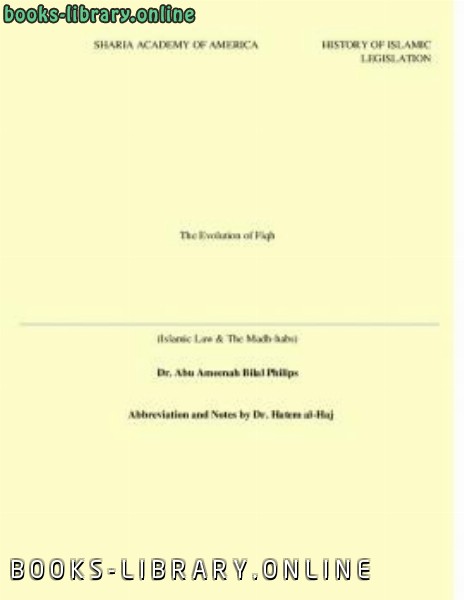📘 قراءة كتاب Evolution of Fiqh أونلاين


INTRODUCTION.................................................................................................................................................8
Fiqh and Sharee‟ah ...........................................................................................................................................8
Fiqh literally means.......................................................................................................................................8
Technically, however, Fiqh refers to ...........................................................................................................8
Sharee‟ah, literally means, ...........................................................................................................................8
Islamically, however it refers to ...................................................................................................................8
The Development of Fiqh..................................................................................................................................9
Madh-habs .......................................................................................................................................................10
The First Stage: FOUNDATION .......................................................................................................................11
The Method of Legislation..............................................................................................................................11
The same was the case of Islamic legislation found in the Sunnah.........................................................11
The reason for this method of legislation ..................................................................................................11
General Content of the Qur‟aan ....................................................................................................................12
The Makkan Period (609-622 CE).............................................................................................................12
The Madeenan Period (622-632 CE) .........................................................................................................12
Qur‟anic Fields of Study.................................................................................................................................13
Legal Content of the Qur‟aan ........................................................................................................................13
The Basis of Legislation in the Qur‟aan........................................................................................................14
Islaam‟s confirmation of some Arab customs...........................................................................................14
Principles of Enactment of Law.....................................................................................................................15
The Removal of Difficulty...........................................................................................................................15
The Reduction of Religious Obligations....................................................................................................15
Realization of Public Welfare.....................................................................................................................16
The Realization of Universal Justice. ........................................................................................................17
Sources of Islamic Law ...................................................................................................................................18
Section Summary.............................................................................................................................................21
3
THE SECOND STAGE: ESTABLISHMENT .................................................................................................22
Problem-solving Procedures of the Righteous Caliph Faced with a new problem ...................................22
The Approach of Individual Sahaabah to Ijtihaad ......................................................................................22
The Absence of Factionalism..........................................................................................................................23
Characteristics of Fiqh During This Period..................................................................................................23
Section Summary.............................................................................................................................................25
THE THIRD STAGE: BUILDING ...................................................................................................................26
This period is noteworthy for three main trends: ........................................................................................26
Factors Affecting Fiqh ....................................................................................................................................26
A. Division of the Ummah...........................................................................................................................26
B. Deviation of the Umayyad Caliphs........................................................................................................26
C. Dispersion of the „Ulamaa......................................................................................................................27
D. Fabrication of Hadeeth ..........................................................................................................................27
Characteristics of Fiqh in the Umayyad Period ...........................................................................................27
Reasons for Differences...............................................................................................................................28
Compilation of Fiqh ........................................................................................................................................28
Section Summary.............................................................................................................................................30
THE FOURTH STATGE: THE FLOWERING..............................................................................................31
The Development of Fiqh................................................................................................................................31
Period of the Great Imaams ...........................................................................................................................31
State Support for Scholars..........................................................................................................................31
Increase in Centers of Learning.................................................................................................................32
The Spread of Debate and Discussion .......................................................................................................32
Period of the Minor Scholars .........................................................................................................................32
Comopilation of Fiqh ..................................................................................................................................32
Court Debates..............................................................................................................................................33
Compilation of Hadeeths ............................................................................................................................34
The Organization of Fiqh ...........................................................................................................................34
The Sources of Islamic Law............................................................................................................................34
4
The Qur‟aan.................................................................................................................................................34
The Sunnah ..................................................................................................................................................34
Opinion of the Sahaabah ............................................................................................................................34
Qiyaas...........................................................................................................................................................34
Istihsaan (Legal Preference).......................................................................................................................35
„Urf (Custom)...............................................................................................................................................35
Section Summary.............................................................................................................................................36
THE MADH-HABS: SCHOOLS OF ISLAMIC LEGAL THOUGHT .........................................................37
THE HANAFEE MADH-HAB ......................................................................................................................37
The founder: Imaam Abu Haneefah (703-767CE)...................................................................................37
Formation of the Hanafee Madh-hab........................................................................................................37
Sources of Law used by the Hanafee Madh-hab ......................................................................................38
Main students of the Hanafee Madh-hab..................................................................................................39
Followers of the Hanafee Madh-hab .........................................................................................................39
THE AWZAA‟EE MADH-HAB....................................................................................................................40
The founder: Imaam al-Awzaa‟ee (708-774 CE)......................................................................................40
Reasons for the Madh-hab‟s Disappearance ............................................................................................40
THE MAALIKEE MADH-HAB....................................................................................................................40
The Founder: Imaam Maalik (717-801 CE) .............................................................................................40
Formation of the Maalikee Madh-hab ......................................................................................................41
Sources of Law Used by the Maalikee Madh-hab....................................................................................41
Main students of the Maalikee Madh-hab ................................................................................................42
Followers of the Maalikee Madh-hab........................................................................................................43
THE ZAYDEE MADH-HAB .........................................................................................................................43
The Founder: Imaam Zayd (700-740 CE).................................................................................................43
Formation of the Zaydee Madh-hab..........................................................................................................43
Sources of Law used by the Zaydee Madh-hab........................................................................................43
Main Students of the Zaydee Madh-hab...................................................................................................44
Followers of the Zaydee Madh-hab ...........................................................................................................45
Section Summary.............................................................................................................................................59
THE FIFTH STAGE: CONSOLIDATION......................................................................................................60
Four Madh-habs..............................................................................................................................................60
Compilation of Fiqh ....................................................................................................................................61
Section Summary.............................................................................................................................................62
THE SIXTH STAGE: STAGNATION AND DECLINE ................................................................................63
Emergence of Taqleed.....................................................................................................................................63
The Blind Following of a Madh-hab..........................................................................................................63
Reasons for Taqleed ........................................................................................................................................64
Taqleed (blind following) has to be distinguished from Ittibaa‟ (reasoned following). ........................64
As for the common people ..........................................................................................................................65
Taqleed was the result of a number of factors..........................................................................................65
Compilation of Fiqh ....................................................................................................................................65
Reformers.........................................................................................................................................................67
Ahmad ibn Taymeeyah...............................................................................................................................67
Muhammad ibn „Alee ash-Shawkaanee ....................................................................................................67
Muhammad „Abduh....................................................................................................................................68
Section Summary.............................................................................................................................................70
THE IMAAMS AND TAQLEED ......................................................................................................................71
The stand taken by the early Imaams and their students towards Taqleed:.........................................73
Imaam Maalik Ibn Anas (717-801 CE) .....................................................................................................74
Imaam ash-Shaafi‟ee (767-820 CE) ...........................................................................................................74
Imaam Ahmad ibn Hambal (778-855 CE) ................................................................................................75
Students of the Imaams...................................................................................................................................76
Comment......................................................................................................................................................76
In Fiqh, totally independent thought is impossible ..................................................................................77
Section Summary.............................................................................................................................................79
10 DIFFERENCES AMONG THE UMMAH ..................................................................................................80
Differences among the Sahaabah...............................................................................................................84
The following are a few examples of their statements .............................................................................85
Section Summary.................................................................................................................................................87
11 CONCLUSION ............................................................................................................................................88
Dynamic Fiqh...............................................................................................................................................88
Proposed Steps.............................................................................................................................................89
[Framework]................................................................................................................................................90
Differenes among Madh-hab‟s rulings fall into two main cetegories;....................................................90
Fiqh and Sharee‟ah
For a proper understanding of the historical development of Islamic law, the terms Fiqh and
Sharee‟ah need to be defined. Fiqh has been loosely translated into English as “Islamic law”
and so has Sharee‟ah, but these terms are not synonymous either in the Arabic language or to
the Muslim scholar.
Fiqh literally means the true understanding of what is intended. An example of this
usage can be found in the Prophet Muhammad‟s statement: “To whomsoever Allaah wishes
good, He gives the Fiqh (true understanding) of the Religion”1
.
Technically, however, Fiqh refers to the science of deducing Islamic laws from
evidence found in the sources of Islamic law. By extension it also means the body of Islamic
laws so deduced.
Sharee‟ah, literally means, a waterhole where animals gather daily to drink, or the
straight path as in the Qur‟anic verse.
“Then we put you on a straight path (Sharee‟ah) in you affairs, so follow it and do not
follow the desires of those who have no knowledge.” Soorah al-Jaathiyah (45): 18.
Islamically, however it refers to the sum total of Islamic laws which were revealed to the
Prophet Muhammad (SW.) and which are recorded in the Qur‟aan as well as deducible from
the Prophet‟s divinely-guided lifestyle (called the Sunnah)2
From the previous two definitions, the following three differences may be deduced:
1. Sharee‟ah is the body of revealed laws found both in the Qur‟aan and in the Sunnah,
while Fiqh is a body of laws deduced from Sharee‟ah to cover specific situations not directly
treated in Sharee‟ah law.
2. Sharee‟ah is fixed and unchangeable, whereas Fiqh changes according to the
circumstances under which it is applied.
3. The laws of Sharee‟ah are, for the most part, general: they lay down basic principles. In
contrast, the laws of Fiqh tend to be specific: they demonstrate how the basic principles of
Sharee‟ah should be applied in given circumstances.
1 Reported by Mu„aawiyah and collected by al-Bukhaaree (Sahih Al-Bukhari (Arabic-English), vol.4, pp. 223-4,
no.346), Muslim, (Abdul Hamid Siddiqi, Sahih Muslim (English Trans.), (Beirut: Dar al-Arabia, n.d.), vol.3, p.
1061, no.4720), at Tirmidhee and others.
2
9 Muhammad Shalabee, all-Madkhal fee at-Ta‟reef bil-fiqh al-Islaamee, (Beirut: Daar an-Nahdah al-
Arabeeyah, 1969), p. 28.
The Development of Fiqh
The development of Fiqh falls traditionally into six major stages named as follows:
Foundation, Establishment, Building, Flowering, Consolidation, and Stagnation and Decline.
These stages occur respectively in the following historical periods:
a) Foundation : the era of the Prophet (SW.) (609-632 CE)10 b)
b) Establishment : the era of the Righteous Caliphs, from the death of the Prophet (SW.) to
the middle of the seventh century CE (632-661)
c) Building: from the founding of the Umayyad dynasty (661 CE) until its decline in the
middle of the 8th century CE.
d) Flowering: from the rise of the „Abbaasid dynasty in the middle of the 8th century CE
to the beginning of its decline around the middle of the 10th century CE. e)
e) Consolidation : from the decline of the „Abbaasid dynasty from about 960 CE to the
murder of the last „Abbaasid Caliph at the hands of the Mongols in the middle of the 13th
century CE.
f) Stagnation and Decline : from the sacking of Baghdad in 1258 CE to the present.
Fiqh (Law)
Correct
Ijtihaad
Shari'aa(Aqeedah-Law-Morals)
Madh-habs
Madh-habs3
have been important instruments for the clarification and application of the
Sharee‟ah. Together, Fiqh and Sharee‟ah should be unifying forces that unite all Muslims
regardless of place, time or cultural background. In fact, the only infallible Madh-hab that
deserves to be followed without any questions asked is that of the Prophet Muhammad
himself (SW.). Only his interpretations of Sharee‟ah can be considered divinely guided and
meant to be followed until the last day of this world. All other Madh-habs are the result of
human effort, and thus are subject to human error. Or as Imaan ash-Shaafi‟ee, founder of the
Shaafi‟ee Madh-hab, so wisely put it, “There isn‟t any of us who hasn‟t had a saying or
action of Allaah‟s messenger (SW.) elude him or slip his mind. So no matter what rulings I
have made or fundamental principles I have established, there will be in them things contrary
to the way of Allah‟s messenger (SW.). However, the correct ruling is according to what the
messenger of Allah (SW.) said, and that is my true ruling.”
This is a great trial from Dr, Hatem to abbreviate the book of Sh. Abu Ameenah Bilal Philips . The overall purpose of this book is to acquaint the reader with the historical factors behind the formulation of Islamic law Fiqh , in order that he or she may better understand how and why the various schools of Islamic law Madhhabs came about.
حجم الكتاب عند التحميل : 742.4 كيلوبايت .
نوع الكتاب : pdf.
عداد القراءة:
اذا اعجبك الكتاب فضلاً اضغط على أعجبني و يمكنك تحميله من هنا:

شكرًا لمساهمتكم
شكراً لمساهمتكم معنا في الإرتقاء بمستوى المكتبة ، يمكنكم االتبليغ عن اخطاء او سوء اختيار للكتب وتصنيفها ومحتواها ، أو كتاب يُمنع نشره ، او محمي بحقوق طبع ونشر ، فضلاً قم بالتبليغ عن الكتاب المُخالف:
 قبل تحميل الكتاب ..
قبل تحميل الكتاب ..
يجب ان يتوفر لديكم برنامج تشغيل وقراءة ملفات pdf
يمكن تحميلة من هنا 'http://get.adobe.com/reader/'


 منصّة المكتبة
منصّة المكتبة 